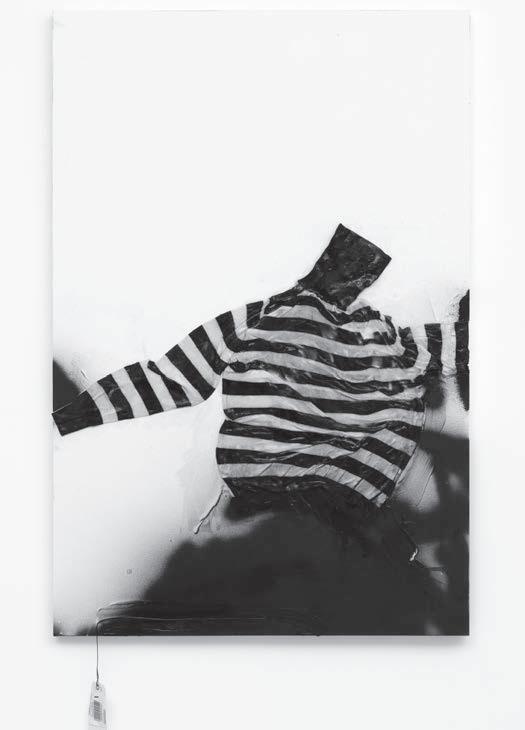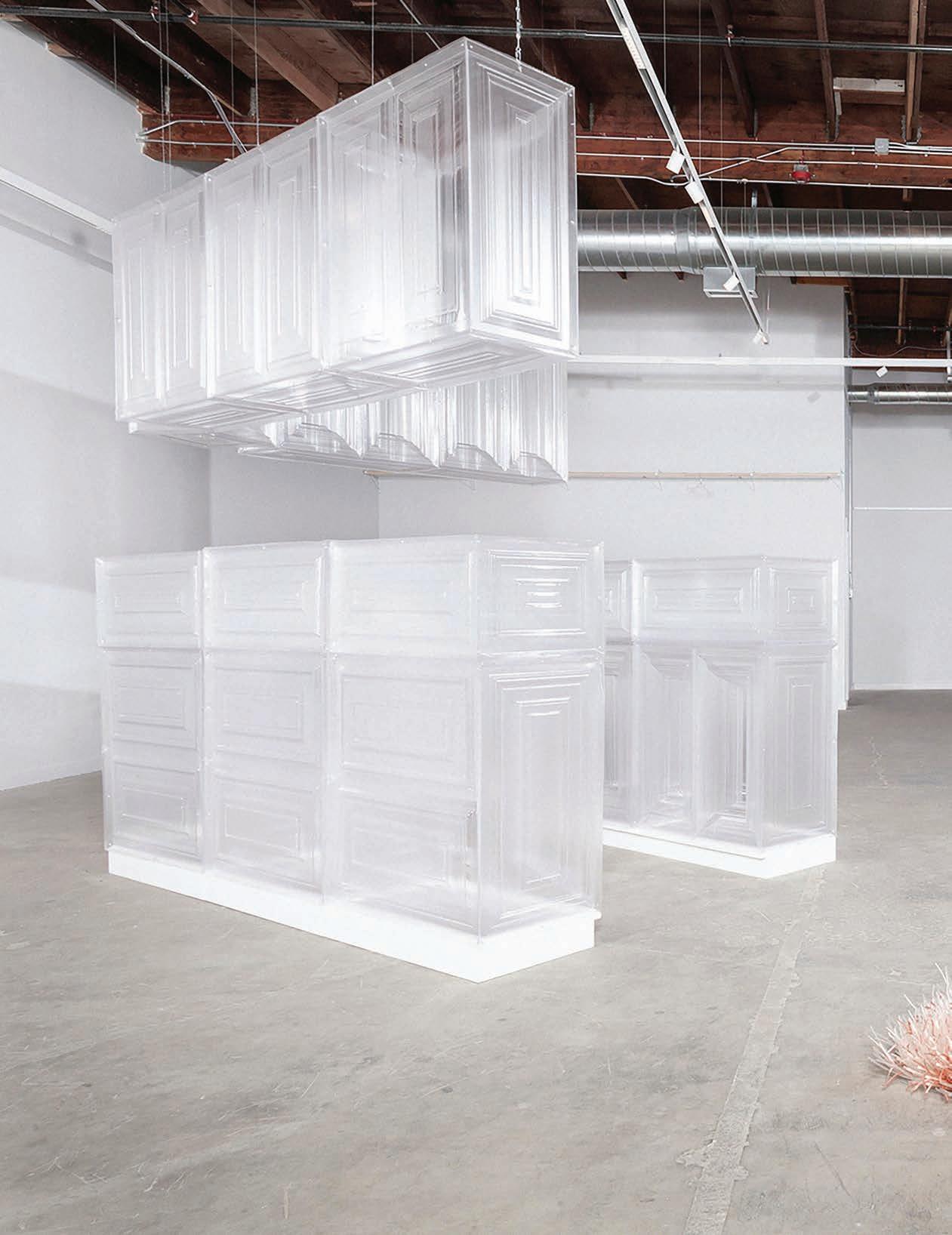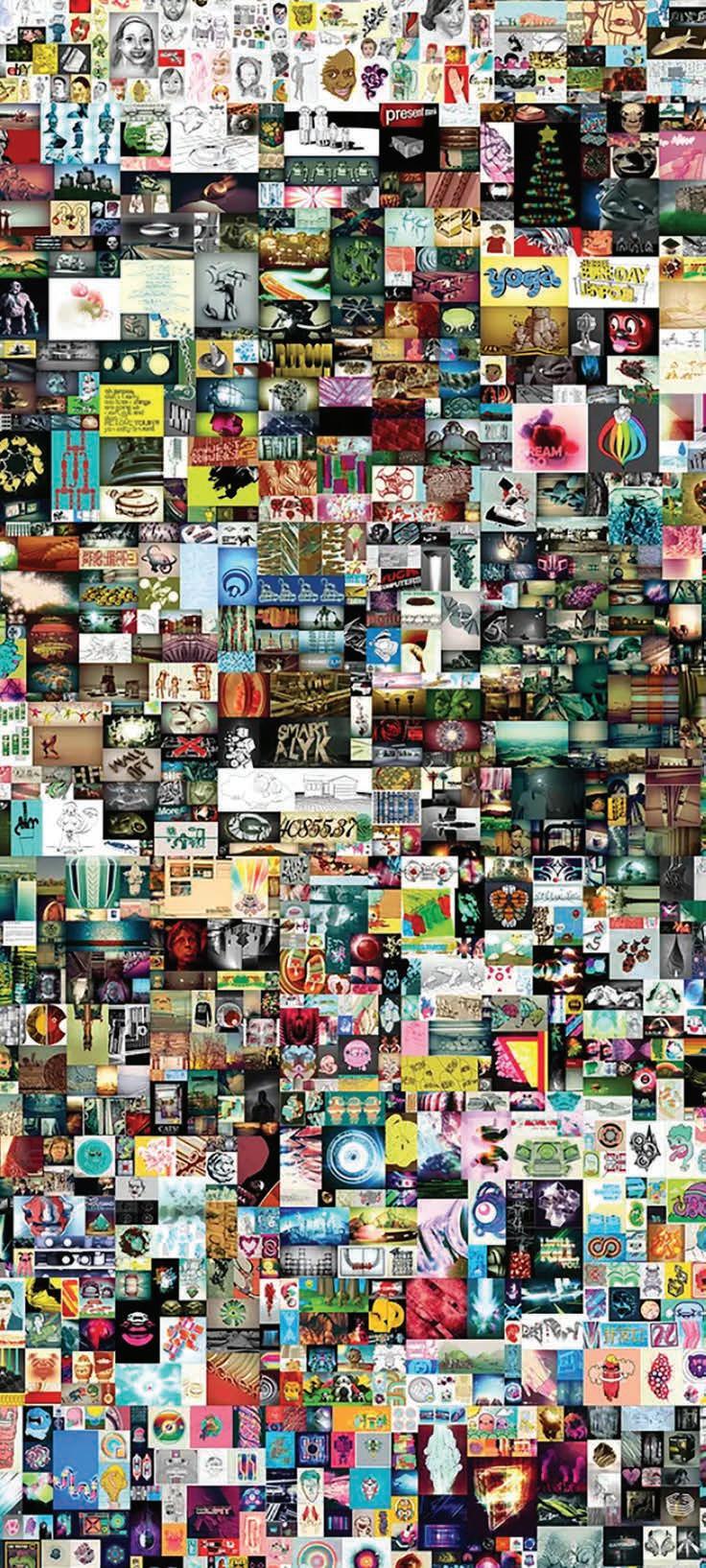R E V I E W S
Tarik Garrett Hunter Shaw Fine Art
documents from official and unofficial voices with contemporary objects and images, Garrett frames prejudices both aesthetically and critically while taking his viewers on a journey through time.
Tarik Garrett’s compelling show addresses how the past intersects with the present. This minimal, mixed-media installation brings together appropriated documents, Polaroid photographs, junked wood, metal fragments, a partial tree trunk equipped with speakers and a portion of chain-link fence. Upon entry, the partially blocked space forces the viewer to navigate around a section of fence that spans the height of the gallery. Caught in the bottom of the chain-link fence are a narrow branch and a few brown leaves, suggesting the outside world where they may have once been subject to the elements. Located toward the front of the gallery and easy to miss are two
Vonn Sumner and Holly Elander KP Projects
Jody Zellen
Tarik Garrett, Installation view, courtesy Hunter Shaw Fine Art, photo by Ruben Diaz.
small white speakers embedded in the wall, from which a rendition of W.E.B. Du Bois’ adaptation of the patriotic song “My Country ‘Tis Of Thee” softly emanates. In the early 1900s, Du Bois’ augmented the original lyrics (written in 1831) to create a more honest depiction of the struggle of African Americans. A symphonic voice recites these altered lyrics and calls attention to racial and social injustices while simultaneously shedding light on how to interpret, or reinterpret, the other objects in the installation. At the far end of the gallery a sawed stump made from cherry wood sits on the floor—titled Moses of the colored man (all works 2021)—the stump functions as a podium with an absent orator whose voice is heard from small speakers that have been inserted into the wood. The soundtrack loops a 10-minute excerpt from Military Governor Andrew Johnson’s 1864 speech, announcing emancipation in Tennessee. In the speech, emotionally and sympathetically read by Garrett and overlaid with a percussive beat, Johnson announces to a Black audience (who are suspicious of the white politician’s promises and words) the end of slavery. Hung on opposite walls are two collage works, 1 and 2, made in collaboration with Kevin O’Neill, in which Xeroxed historical documents about race and property, including the “Virginia Health Bulletin to Preserve Racial Integrity” from 1924; pages from Cheryl Harris’ “Whiteness as Property,” 1993; and Supreme Court rulings on trespassing from 1805, are juxtaposed with Polaroids of vandalized, graffitied and fenced-in properties, as well as images of cinderblock walls. These odd-shaped assemblages are funkily framed with salvaged 2x4s or metal piping— materials that are used in ad hoc as well as sanctioned construction. Garrett’s works speak to the continued struggles and inequities that Black American and other people of color confront in a world of white domination. By weaving together historical songs and
60
By Genie Davis
Artists Vonn Sumner and Holly Elander each offer astonishing exhibitions of intensely personal artworks, that coupled with intimacy also present a prescient commentary on current socio-political times. Sumner’s solo show, “Burning Down the House,” features oil paintings the artist began in 2019—eerily ahead of its times with its empty boarded buildings, fires and dumpsters. Exuding an air of abandonment and mysterious wildness, his images are licked by flames creating a sense of attractive but dangerous purging. In 2020, the idea of “burning down” the urban forest’s growth has a more purposeful attraction. The spare palette, with clean realistic execution of his images, creates a viewing experience that is lighter of heart. Dumpster Fire III (2019) is burning hot with destruction, but the orange and gold flames flare against a neon pink, graffiti-strewn wall as brilliant as any California sunset. Burned Out Building (2020) is an ashy, gravestone-gray, but the graffiti written across lower floors is brightly colored; a rainbow of words, the sky a brilliant dark-periwinkle. Internal flames, perhaps the psychedelic, appear the subject in works such as Byzantine Anonyme (2019). Fire destroys but also resurrects. Elander’s exhibition “Our Home” is quite different in subject and approach, but it too speaks of change to the natural world and the dichotomy of its human imprint. In part inspired by incidents from Elander’s childhood—including a raccoon on the roof, a snake in the driveway and coyotes trailing the family on a walk through the neighborhood—these delightful works bring wild creatures into a mid-century modern home simi- Holly Elander, Mantis, 2021, courtesy KP Projects, photo by @birdmanphotos. lar to the house where Elander grew up. The palette is primarily quieter than in any previous series by the artist, although the vivid yellows of pitcher, background and insect in Mantis (2020) belie that. In other works, the background dissolves, leaving us free-floating in personal space. Regardless of palette and background, the visits by natural creatures from owls to wild cats to the coyotes prowling around a living room piano in Composition (2020) are alluring and magical, filled with immediacy, seemingly floating the viewer into the imaginary home. Whimsical and warm, Elander offers a profound and poignant look at man sharing his space with nature. Her message is as simple as the acrylic works are carefully and delicately wrought. We all share the same planet, and all must be welcome.

























